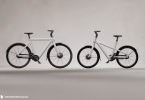Pedelec, range, torque – have you always wanted to know exactly what these terms mean? Our ebike glossary will give you detailed explanations of the most frequently occurring terms. To help you find your way around more quickly, we’ve divided it into general bicycle terminology, components and equipment, as well as specific language relating to motors and drive systems.
The most common terminology for ebikes, frames and tech
Here, we take a closer look at general terms that differentiate different types of ebikes and frames and some basic language for technology.
| Term | Explanation |
|---|---|
| E-compact bike | E-compact bikes are ebikes with a wheel size between 14″ and 24″, a short wheelbase and, usually, a low-slung top tube. |
| Pedelec | Pedelec designates a bicycle with electronic pedal assistance up to 25 km/h. The nominal motor power is limited to 250 W. |
| S-pedelec | The S-pedelec is a more powerful ebike that provides support up to 45 km/h and a continuous motor output of up to 500 W. Unlike pedelecs, S-pedelecs require a licence plate, insurance and an AM driving licence.. |
| Ebike | Ebike is a generic term for an electrically powered bicycle. Ebike is often used as a substitute for the more correct term, pedelec. |
| E-moped | An E-moped is a class L1e moped with an independent electric drive system that doesn’t require you to pedal. E-mopeds are subject to registration and insurance requirements. Helmets that comply with ECE 22 are also compulsory. In addition, you need a class M driving licence to ride one. |
| (E-)cargo bike | A cargo bike or (E-)cargo bike is a special type of bike designed for transporting loads. You can find out everything you need to know in our big cargo bike group test. |
| Folding bike | A folding bicycle has a frame designed to be folded via joints or hinges into a non-rideable but compact and easily transportable/stowable form factor. |
| Diamond frame | The diamond frame sees the front and rear triangles arranged in the shape of a diamond. The top tube often runs almost horizontally, resulting in a high standover. |
| Trapeze frame | In contrast to the diamond frame, the trapeze frame uses a low-slung top tube for easier mounting and dismounting. |
| Step-through frame | The step-through frame eschews the top tube altogether, reinforcing the low-slung down tube for easier access. |
| Standover height | The standover height is the vertical distance from the middle of the top tube to the ground. This is important in relation to the rider’s inseam, with the gap varying depending on the frame shape and leg length. The larger it is, the more comfortable it is to get on and off the bike. |
| Gear ratio | The gear ratio is the ratio of the chainring to the rear sprocket. To be able to maintain a steady cadence at different speeds, the gear ratio is adjusted by shifting gears. |
| Gear range | The gear range is the range between the largest and smallest gear. For a cassette with a largest 50 tooth sprocket and a smallest 10 tooth one, this is 500% (50/10 x 100). |
| Suspension travel | Suspension travel refers to the difference between the maximum extended and compressed position of a suspension fork. The rear travel is measured by the distance the rear wheel axle travels when the shock is fully compressed. Note: bicycles with more travel aren’t automatically better able to cope with large bumps in the road. |
| Connectivity | Connectivity refers to the additional range of functions offered by the networking of electronic components and devices. This includes navigation functionality, fitness tracking, connecting your ebike to a smartphone or fitness sensors, recording rides and options to control and customise the riding behaviour of the ebike using software. |
| Q-factor | The q-factor determines the width of your stance on the bike i.e. the distance between the two cranks. |
| Compliance | Compliance describes the vertical and horizontal flex and damping of the frame and structural components under load. Well-tuned compliance can help mitigate shocks and vibrations and generate increased comfort. |
| Toe overlap | Toe overlap describes the extent of contact of your forward foot with the front tyre when turning the bars with your pedals horizontal. Toe overlap is more common with small frame sizes and bikes with steep steering angles and large tyres. |
The most common terminology for components and equipment
This section covers terms that are often used for components and equipment. These refer to components and parts that are fitted, rather than the bike itself.
| Term | Explanation |
|---|---|
| Shock | The shock is the suspension element which controls the compression and absorbs shocks from the rear frame triangle in response to impacts. |
| Stem | The stem connects the handlebar and the steerer tube. |
| Spacer | Spacers fit around the steerer tube and are placed under the stem to adjust the height of the handlebar to suit your height and preferences. |
| Dropper post | The height of a dropper post can be adjusted with a remote control on the handlebar. This makes it easy to get on and off the bike and also gives you more freedom of movement on the bike when the seat post is dropped out of the way. |
| Hub gears | A hub gear uses a planetary gearbox inside the rear hub which changes gears internally and is often better protected against dirt as a result. |
| Derailleur gears | Derailleur gears are gears where the bicycle chain shifts across sprockets with different numbers of teeth to change the gear ratio. |
| Mechanical shifting | For mechanical shifting, gear cables connect the shifter and derailleurs to control the gears. |
| Electronic shifting | Here, the gears are controlled electronically, with a wired or even wireless signal sent to the derailleur to control it. Small batteries provide the necessary power. |
| Belt drive | A belt drive uses a belt instead of a chain to transmit power from the cranks to the rear wheel. Belt drives on a bicycle usually come in combination with a hub gear and are incompatible with derailleurs. |
The most common terminology for E-drives and motors
Electric motors on ebikes are a complex topic that is more easily explained by unifying common terms. In this section, we explain the most common terms related to E-drives and motors.
| Term | Explanation |
|---|---|
| Power (watts) | The power of ebike motors is specified in watts. Their average or nominal power must not exceed an average of 250 W for 30 min (not S-pedelecs), as enshrined in law in the EU and many other countries. All the motors in our test meet this requirement. However, at peak power, motors can have an output of two, three or even four times this amount. |
| Torque (newton metre) | Torque is expressed in newton metres (Nm) and describes the rotational force a motor can produce. In contrast to the fluctuating power output of a motor, torque is the more meaningful indicator of how strong a motor feels. The higher the torque, the stronger the support you’ll experience. |
| Battery, capacity and watt hours (Wh) | Motors draw their energy from a battery. How long a battery lasts before it is drained depends on its capacity and the “consumption” of the motor. The battery capacity i.e. its “size”, is specified in watt hours (Wh). In theory, a 500 Wh battery will last 2 hours if the motor draws a constant 250 W over this period. In practice, the efficiency of all the components needs to be accounted for, with intrinsic losses meaning the battery will be flat earlier. |
| Push-assist | Push-assist can be activated via a button on the handlebar remote. When it is switched on, the motor pushes the bike forward at up to 6 km/h without pedalling. This helps you out when pushing your bike along. |
| Display | DThe display encompasses the screen or arrangement of LEDs used to display engine stats, ride data and more. In some systems, the display can provide other functions such as navigation. |
| Turbo/Boost/Rocket | These are common terms for the highest motor assistance modes, with different names depending on the manufacturer. |
| Dual-battery | Dual-battery is a designation for a battery concept in which two batteries are installed on or in the ebike instead of one. Depending on the system, the motor can be powered by only one battery or both at the same time. |
| Mid-motor | A motor concept where the motor is integrated into the bottom bracket area of the frame. |
| Hub motor | A motor concept where the motor is located in the front or rear hub. |
| Online configurator | An online configurator offers the option to select, swap and customise individual components on the manufacturer’s website before your purchase. The bike is then delivered in your desired build |
Words: Rudolf Fischer Photos: Various







